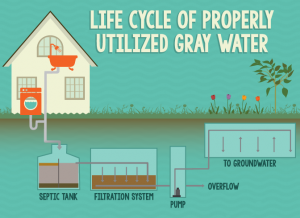Understanding Gray Water Around Your Home
In this day of energy conservation and listening to the pleas of our dying, very damaged environment, we are all in need of tips on how we can live better without depleting our natural resources. One such tip involves planting more trees and living in a greener world, where plants can use their natural ability to turn carbon dioxide in the air into oxygen. Another tip involves conserving water and making sure that one of our most precious commodities is abundant enough to sustain life for all animals, plants, and humans.
 Thus exists a paradox: how can plants live on very little water if we must conserve it; and conversely, how can we conserve water well enough so that we can still allow plants to grow? Scientists are now hard at work trying to genetically engineer plants to grow with very little water, while still others are engineering important food crops to survive with no irrigation. While scientists are working in their laboratories, however, we can still do our part in conserving water while helping the environment through making our plants grow. We can undertake this through gray water rerouting.
Thus exists a paradox: how can plants live on very little water if we must conserve it; and conversely, how can we conserve water well enough so that we can still allow plants to grow? Scientists are now hard at work trying to genetically engineer plants to grow with very little water, while still others are engineering important food crops to survive with no irrigation. While scientists are working in their laboratories, however, we can still do our part in conserving water while helping the environment through making our plants grow. We can undertake this through gray water rerouting.
Gray water is the waste water that we generate from our baths, after we wash the dishes, or after we do the laundry. Black water, on the other hand, is the waste water that we generate from our use of the toilet. The average family with a father, mother, and two children can use up to three thousand liters of gray water a week – water that is wasted and allowed to run down the drain, even though it can still be used.
Check Out: Buffalo Grass, a drought tolerant lawn
Most of today’s gray water will contain small amounts of soap, detergents, and bleach. Soaps and detergents will contain minerals that are important for plant life, although these minerals can be mixed in with industrial chemicals that can do more damage to plants and the soil. Bleaches are even more dangerous: they can damage plant root and shoot tissues, and can persist in the soil for long periods of time.
 Gray water, however, can be treated by being rerouted from your home and into your garden, all through the use of special filtration and treatment tubes. Once gray water is filtered and treated, it can be used to irrigate your home garden. Not only do you help save the environment by allowing more plants to grow, you also conserve water and use what would otherwise go to waste.
Gray water, however, can be treated by being rerouted from your home and into your garden, all through the use of special filtration and treatment tubes. Once gray water is filtered and treated, it can be used to irrigate your home garden. Not only do you help save the environment by allowing more plants to grow, you also conserve water and use what would otherwise go to waste.
If you are planning to use gray water to water your garden, then take note of the following tips before you start. Remember that if you can’t afford the apparatus to directly lead gray water to your garden, you can still do your part in recycling gray water by placing a bucket nearby whenever you do your laundry, wash your plates and utensils, or take a bath. If you use the right soaps and detergents, then you can still use the water in this bucket to water your plants.
Check our Tips for Fire Safe Landscaping for more low water options
- Inquire at your local plumbing and house repair shops on what mechanisms or machines are available to reroute gray water. Some companies will offer surface or sub-surface drip irrigation, which will direct gray water to the roots of plants. These irrigation mechanisms are highly efficient, as they direct water to where plants need it most, and where they are at the best position to absorb it.
- Although most gray water won’t need treatment, you might still need to filter it out for debris or dust that might harm more delicate plants. Inquire at your local plumbing facility on how you can treat the water. For more information, talk to your local florist, horticulturist, landscape artist, or gardening expert on the feasibility of using gray water for your plants, and the safety of gray water for your garden or lawn.
- In general, gray water will contain potassium, phosphorous, and nitrogen, all of which can benefit plants. These minerals are in high abundance in organic soaps and shampoos, so look for the natural or organic label when you buy your detergents. Stay away from industrial chemicals and bleaches.
- If your plants seem to be getting damaged, stop using gray water and have a horticulturist or gardener look at them first.
- Do as much research as you can on the use of gray water. You might be growing vegetables in your garden that might not grow as well, or with the nutrients that you want, if you use gray water. You might also be a professional florist who needs a specific kind of water to irrigate your special flowers. Despite its promise, gray water has its exceptions, so be sure that your plants and lawn can benefit from your use of gray water.



Comments are closed, but trackbacks and pingbacks are open.